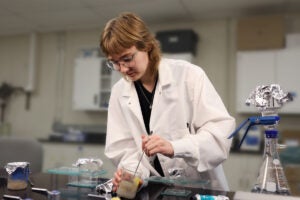In the depths of the Black Sea lies a landscape of eternal darkness. With no light and no oxygen in the sea’s anoxic layer, no life can survive, except perhaps the ghosts of ancient mariners whose ships foundered thousands of years ago.
“Archaeologists have long-suspected the unique composition of the Black Sea held the promise of a perfectly preserved graveyard of shipwrecks, due to the lack of oxygen in the sea’s dead zone,” says Dan Davis, a doctoral candidate in the Department of Classics and research assistant with the Institute of Classical Archaeology (ICA) at The University of Texas at Austin.

Because the environment cannot support the organisms that typically feast on organic materials, such as wood and flesh, there is an extraordinary opportunity for preservation, including shipwrecks and the cargos they carried.
But it wasn’t until Dr. Robert Ballard–head of the Institute of Archaelogical Oceanography at the University of Rhode Island best known for his discovery of the wreck of Titanic–embarked on a series of deepwater surveys of the Black Sea in 1999, that the speculation was proven true.
By 2003, Ballard had discovered several ancient shipwrecks off the coast of Sinop, Turkey. The most famous of these, Sinop D, is a sixth-century Byzantine merchant ship found in the Black Sea’s anoxic waters at a depth of 325 meters. The ship’s discovery made international headlines as the best-preserved ancient shipwreck ever found.
“Suddenly, coming out of the gloom, we saw the mast of that ancient shipwreck–this mythical kind of ship that we’d read about was possible, but no one had ever found one,” Ballard says in the National Geographic television special “Ghost Ships of the Black Sea,” which aired last June. “You’re just mesmerized. Even though you’re a scientist, even though you’ve done this a zillion times, you’re still overwhelmed because it’s so special.”
Ballard and his team could do no more than look at the ancient shipwreck at the initial discovery, but he and his team planned to return in subsequent years with the technology to excavate the exciting find.
To aid in his quest, Ballard tapped the expertise of the university’s Institute of Classical Archaeology, which has a long-term presence on the north coast of the Black Sea at the 2,500-year-old city of Chersonesos in Ukraine.

Watch an OnCampus video about how the end of the Cold War has transformed archaeological research in the Black Sea region.Graphic: Institute for Archaeological Oceanography,University of Rhode Island
Watch an OnCampus video about how the end of the Cold War has transformed archaeological research in the Black Sea region.Graphic: Institute for Archaeological Oceanography,University of Rhode Island
Since 1992, ICA has excavated and preserved the ancient site, under the leadership of the institute’s founder and director Dr. Joseph Carter and in partnership with the National Preserve of Tauric Chersonesos. Other units across campus also have provided support, including the Center for Russian, East European and Eurasian Studies (CREEES), Harry Ransom Center, School of Architecture and School of Information.
“Ballard’s deepwater research adds a new dimension that complements our excavations on land,” Carter says. “At the land site, we’re looking at the crops people were growing and what items they were trading, but the cargo of these ancient shipwrecks may be able to tells us with whom they were trading.”
The city of Chersonesos offers unprecedented insight into the ancient world because it has been home to the Greeks, Romans, Byzantines and Slavs, and survived invasions by the Mongols and Ottoman Turks, among others.
“The Black Sea has been a geopolitical hotspot for centuries,” explains Dr. Thomas Garza, chairman of the Department of Slavic and Eurasian Studies and director of CREEES. “Because so many diverse nations line its shores, it’s been a nexus of trade and a cultural crossroads throughout history.”
Graduate student joins Ballard’s expedition
As a result of Ballard’s collaboration with the university, Davis had the chance to join the legendary oceanographer’s subsequent expeditions to the Black Sea.
Davis’ extensive background in nautical archaeology and experience as a deep-sea rescue diver with the U.S. Navy made him a natural choice for the team, Carter says.
In 2006, Ballard and the team returned to survey the area for more shipwrecks, and last year began excavations on Sinop D, and Chersonesos A, a 10th-century shipwreck found off southern Crimea at a depth of 135 meters.
Although Davis had participated in archaeological excavations throughout the United States, Europe and the Mediterranean, nothing prepared him for the level of preservation of the Black Sea shipwrecks.
“The wood of these ships is preserved in a way that you would never find on a shipwreck anywhere else on the planet,” Davis says. “It’s an extremely exciting environment to explore. But it’s also very eerie, since there’s the high probability in the anoxic layer there will be human remains of people who went down with the ships.”
Aboard the NATO research vessel Alliance, Davis served as one of the watch supervisors for the team’s 2007 survey. A National Geographic film crew documented their work.
With the aid of remote sensing technology and Hercules, a remotely operated vehicle (ROV) equipped with a high definition camera, mechanical arms and a variety of tools, the team began excavation of the two deepwater shipwreck sites.
At Chersonesos A, the team excavated the ship’s cargo of nearly 200 jars commonly found at Byzantine sites on the shores of the Black Sea, including Chersonesos. The bright orange color of the nearly 1,000-year-old jars was completely preserved, to the team’s amazement.

“What they contained is a mystery, but wine is a possibility,” Davis says. “Our theory is the ship may have been transporting wine for a vineyard associated with a Byzantine monastery, since we’ve seen depictions of monks holding jars that look similar to what we found.”
From there, the team sailed to the deeper site, Sinop D, which was the focus of the 2007 survey. The team hoped to answer questions about the ship’s construction, its cargo, and how the anoxic conditions had affected its preservation.
Enigmatic Sinop D puzzles researchers
The team quickly put Hercules to work carefully dredging the site and collecting sediment cores to analyze organic materials in the mud. But the deep mud covering the shipwreck remained a significant obstacle.
“The cargo of Sinop D is completely buried,” Davis says. “The sediment covering the ship is gelatinous on top and turns into a really thick goo as you dig deeper. The ship could be completely full of cargo but we have methodological issues we’re trying to workout in terms of how we’re going to excavate and preserve our findings.”
Davis, whose dissertation explores a new theory of commercial navigation in the ancient Greek and Roman world, also analyzed the ship’s construction in hope of identifying its sailing capabilities.
“Determining whether the ship had a square sail or a lateen (triangular) sail will give us insight into maritime navigation strategies in the ancient world,” Davis says.
The development of the lateen sail revolutionized ancient seafaring because, unlike a square sail, it enabled mariners to sail both with and against the wind.
“Previously, scholars believed that ancient seafarers hugged the shorelines,” Davis explains, “but my research argues that open-sea sailing was actually a common occurrence. The growing record of shipwrecks in deep water far from shore, such as Sinop D, reflects this practice.”
One of the most enigmatic timbers of the ship is a long spar, whose function remains a mystery to the researchers. Unfortunately, the team ran out of time before they could finish fully uncovering the spar, but Davis is hopeful that future excavations may reveal its purpose.
“Sinop D has yet to reveal many secrets, including the contents of the cargo hold,” Davis says. “The obstacle to answering these questions is the deep mud in which the ship is buried. Careful excavation is possible, but we’re not taking any chances.
“As archaeologists, we have the responsibility not only to explore and record sites, but to document them for all time. Since excavation is an inherently destructive process, we have to do it right the first time because there’s no going back.”
Ballard and his team plan additional excavations of Sinop D and Chersonesos A in 2009 and 2010. In the meantime, the researchers have a new target.
This fall, the team returned to the Black Sea on a mission to locate the Armenia, a Soviet hospital ship sunk by German aircraft in 1941. The President of Ukraine, Viktor Yushchenko, is eager to locate the wreck to honor those who died, Davis says.
The Black Sea was a major theater for naval skirmishes in World War II, and the sinking of the Armenia was one of the war’s biggest maritime disasters.
“In less than 10 minutes, more than 7,000 people died in the sinking and the people on the shore could do nothing but watch the tragedy unfold,” Davis says. “If the ship is in the anoxic layer, there’s a good possibility that we’ll find thousands of wounded passengers in a high state of preservation.”
The Black Sea’s graveyard of lost ships offers untold opportunities for research that archaeologists and scholars have only just begun to explore, in part due to the new ROV technologies that have only recently become available for deepwater excavations.
“Many of the methodologies and technologies we’re using in nautical archaeology were originally developed by treasure salvers motivated by profit. But now scholars and archaeologists are finally catching up and even surpassing them, thanks to the help of Ballard and the Institute for Exploration,” Davis says.
Though deepwater explorers like Ballard and Davis are at the forefront of their field, the ocean’s depths remain unconquered. Their expedition was dogged by tempestuous weather conditions and mechanical problems, which serve as a reminder of human frailty in the face of the awesome power of the sea.
Yet Davis remains optimistic about the future of underwater archaeology as new technology makes deepwater excavations of the world’s largest graveyard a reality.
“The ocean has yet to reveal many secrets from our hidden seafaring past,” Davis says. “But it’s the mystery, the challenge and the thrill of discovery that keep us going.”




